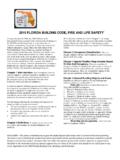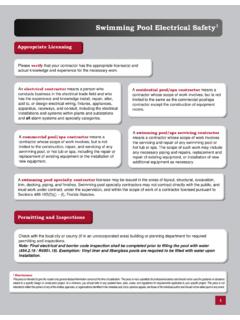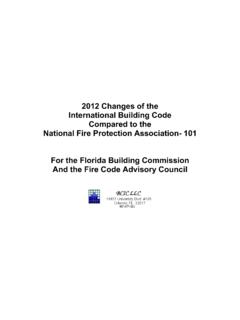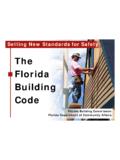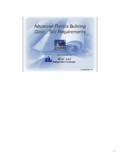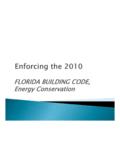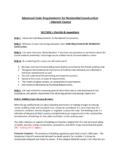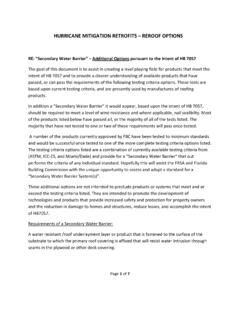Transcription of Analysis of Changes for the 6 Edition (2017) Florida Codes
1 Analysis of Changes for the th 6 Edition ( 2017 ) Florida Codes Changes to the Florida building code , Existing building This Analysis of Changes for the 6th Edition ( 2017 ) of the Florida Codes is intended to provide a comprehensive comparison of the provisions in the 5th Edition (2014) Florida building code , Existing building (FBCEB) and the 6th Edition ( 2017 ) Florida building code , Existing building . The 2012 International Existing building code was the base code for the 5th Edition (2014) FBCEB. The 2015 International Existing building code is the base code for the 6th Edition ( 2017 ) FBCEB. As a result of changing the base code and Florida -specific amendments, certain provisions and criteria of the code have changed. This Analysis will serve a useful tool to facilitate the transition to the new code . This Analysis is arranged so that comparable provisions in the two Codes can be easily located. The left two columns contain section numbers and a brief overview of the corresponding requirements from the 5th Edition (2014) FBCEB.
2 The next two columns contain section numbers and a brief overview of the corresponding requirements in the 6th Edition ( 2017 ) FBCEB. The far right column contains a brief Analysis or comment on the differences between the provisions. This Analysis is not intended to replace or interpret the provisions contained in either the 5th Edition (2014) or the 6th Edition ( 2017 ) FBCEB. This information simply points out the differences. The Analysis is not designed to be used without the aid of the representative code books, as all the details pertaining to a specific section may or may not be provided. However, this Analysis will provide an easy means for identifying differences in the two Codes , as well as enabling the user to locate issue specific provisions in the 6th Edition ( 2017 ) FBCEB by means of a numbered section cross reference. This Analysis provides a cross-reference for the majority of the sections that changed in the 6th Edition ( 2017 ) FBCEB. In some cases, sections were grouped together due to substantial differences.
3 This grouping enables the extent of the differences to be more readily identified. Notable Changes deemed to be the most significant or to have the greatest impact have been highlighted in yellow. Note: Seismic loading and snow loading provisions in the code are no longer reserved (deleted) in the 6th Edition ( 2017 ) FBCEB, even though they do not apply in the State of Florida . While there are Changes to some of these sections and provisions, they are not shown here in this Analysis because they do not apply to construction in the State of Florida . 5th Edition (2014) FBCEB 6th Edition ( 2017 ) FBCEB. Analysis Section Requirement Section Requirement Chapter 2: Definitions New definition of approved added to the - - 202 Definitions: Approved code consistent with definitions in the other Codes . Definitions: change of Definition revised to be more consistent with 202 202 Definitions: change of Occupancy Occupancy the way the term is defined in the FBCB. New definition referring to portions of the - - 202 Definitions: Deferred Submittal design that are not submitted at the time of the application.
4 New definition for buildings constructed and - - 202 Definitions: Relocatable building designed to be reused multiple times and transported to different building sites. 202 Definitions: Repair 202 Definitions: Repair Definition revised for clarity. New definition added applicable to the - - 202 Definitions: Reroofing reroofing provisions and is consistent with the definition in the FBCB and FBCR. New definition added applicable to the - - 202 Definitions: Roof Recover reroofing provisions and is consistent with the definition in the FBCB and FBCR. New definition added applicable to the - - 202 Definitions: Roof Repair reroofing provisions and is consistent with the definition in the FBCB and FBCR. New definition added applicable to the - - 202 Definitions: Roof replacement reroofing provisions and is consistent with the definition in the FBCB and FBCR. Definitions: Substantial Definitions: Substantial Structural 202 202 Definition revised for clarity. Structural Damage Damage 202 Definitions: Sunroom - - Definition deleted.
5 202 Definitions: Value - - Definition deleted. Chapter 3: Provisions for All Compliance Methods Revised for clarity by deleting superfluous General General language. Existing section of the FBCEB relocated to - - Existing materials Chapter 3 so that it applies to all compliance methods. Existing section of the FBCEB relocated to - - New and replacement materials Chapter 3 so that it applies to all compliance methods. Existing section of the FBCEB relocated to - - Occupancy and use Chapter 3 so that it applies to all compliance methods. New section providing charging language for alterations, repairs, additions, and relocation - - Swimming pools of equipment at existing swimming pools regardless of the compliance method chosen. New section addressing ground-fault circuit- Ground-fault circuit-interrupter interrupter protection for personnel for - - protection for personnel alterations, repairs, additions, and relocation of equipment at existing swimming pools. New section addressing equipotential bonding for personnel for alterations, - - Equipotential bonding repairs, additions, and relocation of equipment at existing swimming pools.
6 Chapter 4: Prescriptive Compliance Method New section requiring evaluation and potential retrofit of roof diaphragm, roof diaphragm connections, and roof-to-wall connections where more than 50% of the roof covering is removed. This requirement has existed for Level 1 alterations and is now applicable to the prescriptive Roof diaphragms resisting wind - - compliance method. Five exceptions to this loads in high wind regions requirement are provided. Exception 4. refers to Sections and for site- built single family dwellings. Exceptions 1, 2, and 5 apply to buildings permitted to the specified Codes . Exception 3 applies to buildings with steel or concrete moment resisting frames. New section addressing alterations that - - Refuge areas affect the configuration of an area utilized as a refuge area. New section requiring that the required capacity of refuge areas for smoke - - Smoke compartment compartments in Group I-2 and I-3 be maintained as prescribed in the FBCB. New section addressing the required - - Ambulatory care capacity refuge areas of ambulatory care facilities required to be separated.
7 New section requiring that the required - - Horizontal exits capacity of refuge areas in horizontal exits be maintained. Extent of repair for compliant Extent of repair for compliant Revised for clarity by deleting unnecessary buildings buildings language. Less than substantial structural Less than substantial structural Revised for clarity by deleting unnecessary damage damage language. New section requiring the installation of Replacement wind opening control window opening control devices in Groups - - devices R-2 and R-3 where an existing window is replaced for the conditions specified. New section exempting replacement Replacement window emergency windows from comply with the emergency - - escape and rescue openings escape and rescue provisions in the FBCB. provided the specified conditions are met. Revised for clarity to coordinate with the revision to definition of change of occupancy. New language added requiring Conformance ( change of that Changes in use or occupancy shall Conformance ( change of occupancy).)
8 Occupancy) result in the existing building being no less complying with the provisions of this code than the existing building was prior to the change . New section addressing Changes in - - change in the character of use occupancy with no change of occupancy classification. Chapter 5: Classification of Work Occupancy and use Occupancy and use Section relocated to Section New language added requiring reroofing to Application (Repairs) Application (Repairs). comply with the provisions of Section 706. The term aggregate area of the building . Scope (Alteration Level 3) Scope (Alteration Level 3). has been changed to building area.. Chapter 6: Repairs New language added requiring repairs to Scope Scope also comply with Section 706. Smoke alarms in one-family Smoke alarms in one-family and Section revised to clarify it applies to Level 1. and two-family dwellings and two-family dwellings and townhomes alterations. The exemption for fire alarm, townhomes smoke detector, smoke alarm, or ancillary component that is electronically connected as a part of a centrally monitored or supervised alarm system has been revised to state it's those that use a low-power, radio frequency wireless communication signal; or those that contains multiple sensors, such as a smoke alarm combined with a carbon monoxide alarm or other multi-sensor devices, and is approved and listed by a nationally recognized testing laboratory.
9 Section revised to clarify that repairs also Repairs to damaged buildings Repairs to damaged buildings have to comply with Section 706, Existing Roofing when applicable. Chapter 7: Alterations Level 1. New section requiring the installation of window opening control devices in Groups - - Window opening control devices R-2 and R-3 where an existing window is replaced for the conditions specified. New section exempting replacement Emergency escape and rescue windows from comply with the emergency - - openings escape and rescue provisions in the FBCB. provided the specified conditions are met. Section revised to clarify it applies to Level 1. alterations. The exemption for fire alarm, smoke detector, smoke alarm, or ancillary component that is electronically connected as a part of a centrally monitored or supervised alarm system has been revised Smoke alarms in one-family Smoke alarms in one-family and to state it's those that use a low-power, and two-family dwellings and two-family dwellings and townhomes radio frequency wireless communication townhomes signal; or those that contains multiple sensors, such as a smoke alarm combined with a carbon monoxide alarm or other multi-sensor devices, and is approved and listed by a nationally recognized testing laboratory.
10 Roof diaphragms resisting wind Roof diaphragms resisting wind Five new exceptions to this requirement are loads in high wind regions. loads in high wind regions. provided. Exception 4 refers to Sections and for site-built single family dwellings. Exceptions 1, 2, and 5 apply to buildings permitted to the specified Codes . Exception 3 applies to buildings with steel or concrete moment resisting frames. New language requiring the 8d ring shank Supplemental fasteners for roof Supplemental fasteners for roof supplemental fasteners to be ASTM F 1667. decking attachment decking attachment classification RSRS-01 ring shank nails. Underlayment provisions for areas outside Roof secondary water barrier Roof secondary water barrier for the HVHZ have been deleted and replaced for site-built single family site-built single family residential with a reference to Section of the residential structures structures FBCR. Chapter 8: Alterations Level 2. Smoke barriers - - Section deleted. Revised to refer to Section of the Compartmentation Smoke compartments Florida building code , building to provide a higher level of fire safety for Group I-2.

